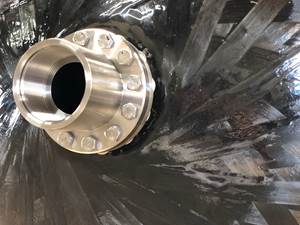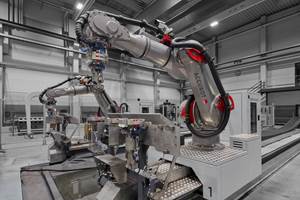Carver Non-Wovens, R3 Composites expand
Carver, which only began commercial production in July, is now beginning its Phase 2 installation work and expects that to be completed by the end of October.
R3 Composites Inc., a custom compression molder and compounder of sheet-molding compound (SMC) with design and part-conversion capabilities headquartered in Grabill, Ind., and its wholly owned subsidiary, Carver Non-Woven Technologies LLC, which supplies single- and multi-material non-woven products from its Freemont, Ind. headquarters, are both in the process of expanding to serve their respective customer base better.
Carver, which only began commercial production in July, is now beginning its Phase 2 installation work and expects that to be completed by the end of October. The new work involves adding three additional opening lines for a total of six. The company also will add an additional blending line, another cross- lapper and an additional card. Once installation of the second opening and blending lines is complete, Carver's production volume for non-wovens will increase to nearly 3,000 kgs per hour. Additionally, the new equipment will enable Carver researchers to expand their developmental work on hybrid non-wovens, by adding more synthetic fibers to the mix as well as carbon fiber, including compound development for applications where higher impact strength, acoustical damping, heat-deflection temperature, and structural requirements are needed in a single application. The second line allows for construction of a single web incorporating up to six different fiber types in two different layers that will subsequently be combined into a single finished, needled product. This unique capability allows Carver to fully customize its non-woven products to help customers optimize for cost, weight, and aesthetics in their final molded composite parts and meet more challenging application requirements.
Further, Carver also is reportedly the first commercial non-wovens manufacturer in the world to install a line designed to run blends with up to 80% carbon fiber content. With this capability, the company already has begun discussions with commercial aircraft manufacturers about developing non-woven carbon fiber blends for aircraft interior components that contain both virgin and recycled carbon fiber. Further, Carver has begun development with an automaker on a custom blend containing carbon fiber for lightweight door trim panels.
Since its July startup, Carver has been producing both synthetic (polymer-based) and blends of synthetic and E-glass or natural fiber mats for customers in a number of industries. Interestingly, one trend the company already is seeing is that customers who previously had been using a scrim backing between non-wovens and a fabric face skin have been able to eliminate the scrim. Customers report being surprised that the new non-wovens from Carver are processing so well, and doing so without wrinkles, which can be a challenge when using the normally necessary scrim. "We call this the winning trifecta," notes Mark Glidden, president, R3 Composites and Carver Non-Woven. "By eliminating the scrim, customer save weight and cost, plus achieve better appearance."
Even more interesting, this ability to eliminate scrim occurred during sampling of some of the first products Carver produced on new equipment in the new facility. Furthermore, these products were made while the company was only using the worker needles at the front end of the needling process and had yet to start using the finish needles at the rear of the process.
Success with these early projects has now led to an order for material for an automotive battery tray. Carver's unique opening and needling layouts also are enabling the company to work with customers on non-wovens featuring higher temperature synthetic fibers. For example, one development project between Carver and a fiber supplier is focused on replacing conventional polypropylene while maintaining the same processing parameters yet achieving higher heat-deflection temperature and higher fiber wetout.
Another change that affects both Carver as well as R3 is the opening of a new shared testing laboratory at the Carver location. "We now can do our own fogging, moisture, burn and E84 simulation tests, as well as mechanical testing in-house following A2LA procedural rules," says Mark Glidden, president of R3 Composites and Carver Non-Woven. "We used to have to send our samples out to external services and wait. Now we can work much more efficiently and respond to customer requests a lot faster."
R3 itself is busy working with a resin supplier on formulating and compounding 1.2 specific gravity (SG) sheet-molding compound (SMC) grades for automotive Class A and structural applications. Once the 1.2 SG formulations are set, R3 and the resin supplier plan to continue working on 1.1 and 1.0 SG products, which R3 will then mold for its automotive customers. Additionally, Glidden notes that R3 is molding more glass-mat thermoplastic (GMT) composites. Still another change is that one of R3's three paint lines has been refurbished and is up and running, allowing the company to offer additional service to customers in many industries.
Related Content
The next-generation single-aisle: Implications for the composites industry
While the world continues to wait for new single-aisle program announcements from Airbus and Boeing, it’s clear composites will play a role in their fabrication. But in what ways, and what capacity?
Read MoreInfinite Composites: Type V tanks for space, hydrogen, automotive and more
After a decade of proving its linerless, weight-saving composite tanks with NASA and more than 30 aerospace companies, this CryoSphere pioneer is scaling for growth in commercial space and sustainable transportation on Earth.
Read MoreAutomated robotic NDT enhances capabilities for composites
Kineco Kaman Composites India uses a bespoke Fill Accubot ultrasonic testing system to boost inspection efficiency and productivity.
Read MoreOtto Aviation launches Phantom 3500 business jet with all-composite airframe from Leonardo
Promising 60% less fuel burn and 90% less emissions using SAF, the super-laminar flow design with windowless fuselage will be built using RTM in Florida facility with certification slated for 2030.
Read MoreRead Next
Ceramic matrix composites: Faster, cheaper, higher temperature
New players proliferate, increasing CMC materials and manufacturing capacity, novel processes and automation to meet demand for higher part volumes and performance.
Read MoreUltrasonic welding for in-space manufacturing of CFRTP
Agile Ultrasonics and NASA trial robotic-compatible carbon fiber-reinforced thermoplastic ultrasonic welding technology for space structures.
Read MoreCutting 100 pounds, certification time for the X-59 nose cone
Swift Engineering used HyperX software to remove 100 pounds from 38-foot graphite/epoxy cored nose cone for X-59 supersonic aircraft.
Read More











